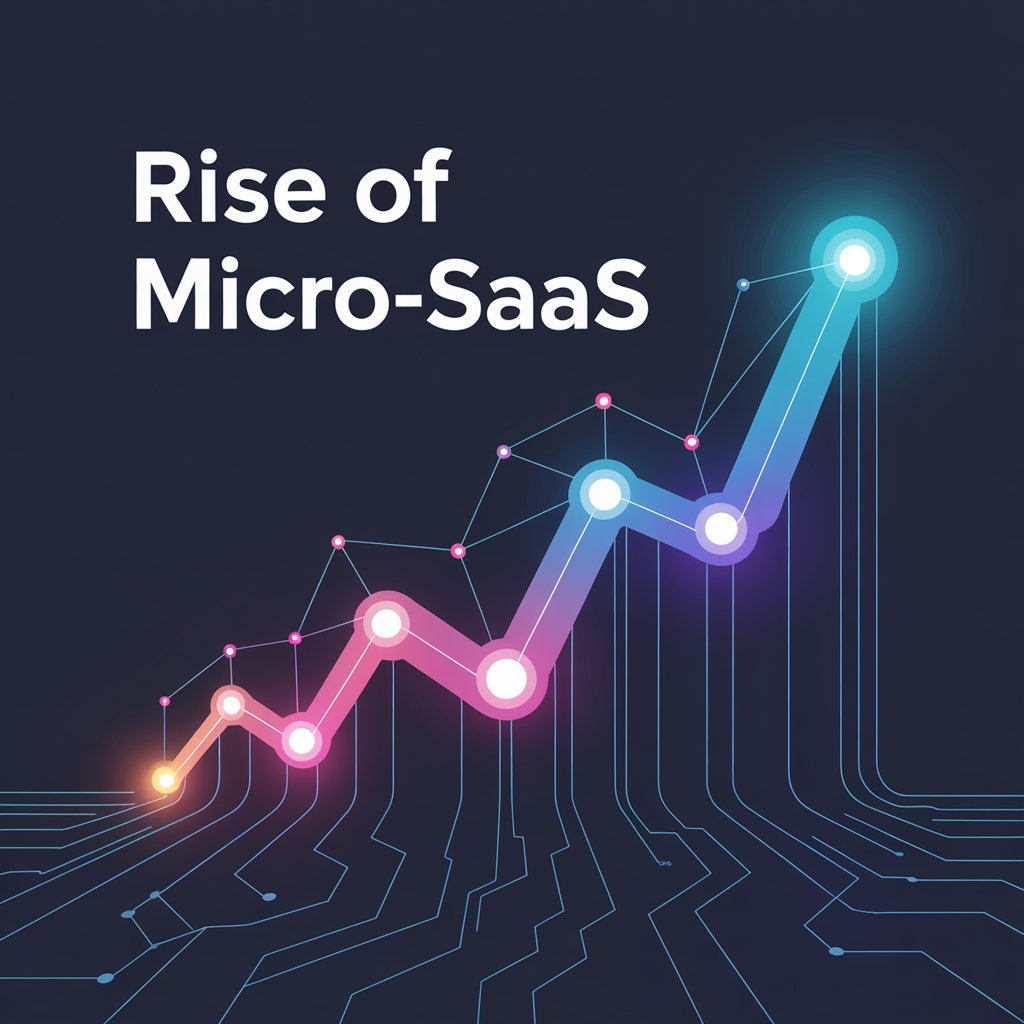In today’s crowded software marketplace, where billion-dollar SaaS giants dominate headlines, a quiet revolution is unfolding in the shadows. Micro-SaaS—small, nimble, highly-focused software products—are capturing the attention of both entrepreneurs and investors. These specialized solutions, often built by solo founders or tiny teams, are proving that in software, sometimes less is truly more. As we move through 2025, the Micro-SaaS movement isn’t just growing—it’s fundamentally reshaping how software gets built, marketed, and monetized.
The numbers speak for themselves: while traditional SaaS companies require extensive funding, large teams, and years to gain traction, Micro-SaaS products are generating remarkable returns with minimal investment. According to industry analysis, the Micro-SaaS sector has seen a 300% year-over-year increase in new ventures. What makes this trend particularly compelling is its accessibility; unlike conventional SaaS models that demand substantial capital, Micro-SaaS democratizes entrepreneurship, allowing developers to compete effectively regardless of resources.

What Exactly is Micro-SaaS?
Micro-SaaS refers to small-scale Software as a Service businesses that focus on solving very specific problems for narrowly defined audiences. Unlike enterprise SaaS platforms that offer comprehensive suites with dozens of features, Micro-SaaS products typically deliver one core functionality exceptionally well. These applications are often developed and maintained by small teams, or even solo entrepreneurs, requiring significantly less overhead while achieving impressive profitability.
The key differentiator lies in the specialized nature of these solutions. While traditional SaaS might target an entire industry, Micro-SaaS hones in on a single pain point within a specific niche. As attractgroup.com explains: “Micro SaaS companies are making a big impact. They focus on specialized services for specific needs.” This laser focus allows them to serve their target audience with unparalleled precision—something larger competitors simply cannot replicate due to their broader scope.
Core Characteristics of Micro-SaaS
| Feature | Traditional SaaS | Micro-SaaS |
|---|---|---|
| Team Size | 10+ employees | Solo founder or 2-3 people |
| Development Timeline | 6-24 months | 1-6 months |
| Feature Set | Comprehensive suite | Single-core functionality |
| Target Market | Broad industry or vertical | Hyper-specific niche |
| Pricing Model | Tiered subscriptions ($50-$500+/user/month) | Simple pricing ($5-$50/month) |
This business model flourishes because it avoids common SaaS pitfalls like feature bloat and complex sales cycles. Micro-SaaS products often serve what hostinger.com describes as “very specific niche[s]” with minimal technical overhead.
Why Micro-SaaS is Exploding in 2025
Three powerful trends are converging to make 2025 the perfect environment for Micro-SaaS success. First, developers now have access to unprecedented technical infrastructure. As the dev.to article highlights: “Serverless & Edge Computing – Hosting is cheaper, scaling is automatic.” With platforms like Vercel, Netlify, and AWS Amplify handling infrastructure, Micro-SaaS founders can focus solely on solving customer problems rather than managing servers.
Second, the market has evolved to embrace specialized tools. Businesses now understand that “best-of-breed” solutions often outperform monolithic platforms. Consumers have become comfortable subscribing to multiple niche tools rather than one all-in-one solution that does everything poorly. The search results reveal this shift: “Niche audiences are happy to pay small amounts for tools that work.”
“The Micro-SaaS model allows developers to monetize their expertise in ways previously impossible. With low barriers to entry, you can validate ideas quickly and generate revenue while maintaining design integrity.”
— Adapted from Building MicroSaaS in 2025: The Complete Guide for Solopreneurs
Finally, the rise of no-code/low-code tools has democratized software development. Products like Bubble, Softr, and Webflow enable non-technical founders to build functional SaaS applications without writing a single line of code. This dramatically lowers the barrier to entry and accelerates time-to-market for Micro-SaaS ventures.
Real-World Micro-SaaS Success Stories
Perhaps the most compelling evidence of Micro-SaaS viability lies in the success stories emerging across the landscape. Consider the example from dev.to: “Clean Voice: Automates podcast editing – pulling in $20,000 MRR.” This solo-founded business solves one specific problem—podcast audio cleanup—and has achieved remarkable traction by focusing exclusively on that need.
Another compelling case is the Financial Projection Tool mentioned in the same article, which “helping users visualize net worth for under $10/month.” This tiny application serves a narrow but valuable need for personal finance enthusiasts at an accessible price point, demonstrating how Micro-SaaS can thrive in seemingly saturated markets by targeting underserved segments.
Here’s why these examples resonate with the Micro-SaaS ethos:
- Problem-first approach: Each solution addresses a specific, measurable pain point
- Lean operations: Minimal team size keeps costs low while maintaining quality
- Clear value proposition: Customers immediately understand what they’re paying for
- Sustainable pricing: Affordable entry points encourage trial and reduce churn
Micro-SaaS founders aren’t trying to build the next Salesforce—they’re creating indispensable tools for specific communities, one niche problem at a time.
How to Identify a Winning Micro-SaaS Opportunity
The most successful Micro-SaaS products emerge from genuine frustration, not manufactured problems. Your goal should be finding “hair-on-fire” problems—those so painful that customers will eagerly pay to solve them. Start by examining your own frustrations or those of communities you belong to. The satisfyhost.com guide emphasizes that Micro-SaaS works best when “cater[ing] to specific industries, communities, or problems.”
The Opportunity Identification Framework
Follow this proven process to uncover viable Micro-SaaS ideas:
- Document recurring problems in your professional or personal life
- Validate pain intensity by talking to 20+ potential users
- Assess monetization potential (would people actually pay?)
- Analyze competitive landscape (is there space for a specialized solution?)
- Estimate development complexity (can you build an MVP quickly?)
“The sweet spot for Micro-SaaS lies at the intersection of your expertise, market demand, and technical feasibility. Don’t chase trends—solve problems you genuinely understand.”
— Adapted from 20 Best Micro SaaS Ideas in 2025
Common Micro-SaaS opportunity categories showing particular promise in 2025:
- Marketing automation tools for specific platforms (TikTok, Pinterest, etc.)
- Analytics tools for underserved industries
- Niche productivity enhancers for specialized workflows
- Custom integrations between popular platforms
- Industry-specific compliance solutions
Building Your First Micro-SaaS: A Practical Guide
Contrary to traditional SaaS development, building a Micro-SaaS requires a ruthlessly focused approach. Forget elaborate feature lists—your goal is to solve one problem exceptionally well. The hostinger.com guide outlines essential steps for Micro-SaaS development, emphasizing minimal viable products and rapid iteration.
The Lean Micro-SaaS Development Process
- Validate before you build: Create a landing page describing your solution and collect email signups
- Build the absolute minimum: Focus on the single core functionality that solves the primary problem
- Charge from day one: Implement payment processing before feature completion
- Iterate based on user feedback: Add features only when multiple customers request them
- Automate everything possible: Leverage tools like Zapier to handle integrations
:::tip Pro Tip
Before writing a single line of code, manually fulfill your service for the first 10 customers. If you find yourself doing the same task repeatedly, that’s your product! This “Wizard of Oz” testing validates demand while clarifying what to automate first.
:::
The most successful Micro-SaaS founders treat their MVP as a conversation starter with customers, not a finished product. Your initial version should barely work—but work exceptionally well for the specific problem it addresses.
Monetization Strategies That Actually Work
Micro-SaaS requires fundamentally different monetization approaches than traditional SaaS. With limited features comes limited pricing potential, but also reduced customer acquisition costs and simplified value communication. The search results reveal a critical insight: niche audiences are “happy to pay small amounts for tools that work.”
Effective Micro-SaaS Pricing Models
- Pay-Once, Use-Forever: As highlighted in the dev.to resource, this model works exceptionally well for tools with limited feature sets and minimal ongoing maintenance
- Tiered by usage: Simple pricing based on core activity metrics (e.g., number of projects, documents processed)
- Flat-rate subscription: $5-$50/month for unlimited access to the core functionality
- Freemium with essential premium: Free basic access with payment required for the one critical feature
Most Micro-SaaS founders make the mistake of underpricing their solutions. If your tool genuinely solves a painful problem, customers will pay significantly more than you expect. Start with higher pricing than feels comfortable—you can always lower it later, but raising prices after establishing a customer base creates unnecessary churn.
“The most successful Micro-SaaS products charge enough to sustain development while remaining accessible to their target audience. Underpricing signals low value and attracts problematic customers.”
— Paraphrased from industry best practices
The Future of Micro-SaaS: What to Expect in 2026 and Beyond
The dev.to prediction that “2026 Will Be the Year of Micro-SaaS” isn’t just hype—it’s grounded in observable market shifts. Three trends will accelerate Micro-SaaS adoption through 2026:
- AI-powered specialization: Micro-SaaS products will increasingly leverage AI to deliver hyper-personalized solutions at scale
- Micro-SaaS marketplaces: Platforms dedicated to discovering and purchasing niche tools will emerge
- Consolidation opportunities: Successful Micro-SaaS products will become acquisition targets for larger platforms seeking specialized capabilities
The solo founder movement will continue gaining momentum as more developers recognize they don’t need venture capital to build sustainable businesses. In fact, the search results suggest that “Solopreneur Pricing Psychology” is becoming a critical skill for Micro-SaaS success, with founders learning to optimize pricing without traditional sales teams.
Emerging Micro-SaaS Opportunities to Watch
| Category | Specific Opportunity | Potential Market Size |
|---|---|---|
| Creator Economy | YouTube chapter generator | 50M+ content creators |
| Real Estate | Lead response automation | 2.5M+ agents in US |
| E-commerce | TikTok Shop analytics | 1.7M+ US merchants |
| Healthcare | HIPAA-compliant scheduling | 900k+ medical practices |
| Education | LMS gradebook integrations | 120k+ educational institutions |
According to satisfyhost.com, Micro-SaaS “continues to rise as an ideal business model for both novice and experienced entrepreneurs” precisely because it accommodates both part-time and full-time development efforts.
Conclusion: Your Micro-SaaS Journey Starts Now
The rise of Micro-SaaS represents one of the most democratizing forces in software history. No longer do you need millions in funding, large teams, or complex infrastructure to launch a sustainable software business. As we’ve seen through real-world examples, even solo developers can build products generating $5,000-$20,000 in monthly recurring revenue by solving specific problems exceptionally well.
The barriers to entry have never been lower, while the potential rewards have never been clearer. If you’ve been waiting for the “right time” to launch your software idea, that time is now. Start small, think specific, and build something that genuinely solves a painful problem for a narrowly defined audience.
Your Micro-SaaS journey doesn’t require perfection—it requires clarity, focus, and the willingness to start before you feel ready. The market is waiting for your specialized solution. What specific problem will you solve today? Remember, in the world of Micro-SaaS, the smallest ideas often yield the most sustainable businesses.
As you embark on your Micro-SaaS journey, keep these final principles in mind:
- Solve one problem exceptionally well rather than many problems poorly
- Charge enough to validate real demand
- Leverage modern infrastructure to minimize technical overhead
- Talk to customers daily, not just during development
- Start before you feel ready—perfection is the enemy of Micro-SaaS success
The software landscape no longer belongs exclusively to well-funded startups. In 2025 and beyond, the future belongs to focused entrepreneurs building meaningful solutions—one micro problem at a time.
